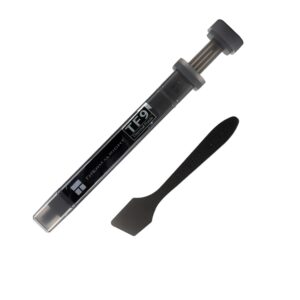Compact and lightweight, this 1.45-ounce tube (3.15″ x 7″ x 0.39″) is easy to handle and store.
- Model: TF9 2.9g-d6
- Manufacturer: Thermalright
- First Available: April 26, 2022
- ASIN: B09YSXDSTR
A top-rated choice (#150 in Silicon Grease) with a solid 4.0-star rating from 69 reviews.
Of course! The phrase “Thermal resistance:” is a great starting point. To improve it, we need to know the context. Are you defining it, using it in a calculation, or presenting it in a report?
Here are several improved versions, categorized by purpose.
1. For a Definition or Introduction (Most Common Improvement)
The original phrase is a noun. To make it a proper sentence or a clear heading, you need a verb.
- Basic Improvement: Thermal resistance is a measure of a material’s ability to resist heat flow.
- More Formal (Technical Report): The thermal resistance, denoted by Rθ or Rth, is a fundamental property used to quantify the opposition to heat transfer through a material or across an interface.
- As a Clear Heading:
- Concept:
### What is Thermal Resistance? - Technical:
### Thermal Resistance (Rθ)
- Concept:
Why this is better: It provides a complete thought instead of just a label.
2. For a Calculation or Data Presentation
If you are stating a specific value, the original phrase is incomplete.
- Basic Improvement: Thermal resistance, Rth = 2.5 K/W
- Better (Clear Units): The calculated thermal resistance is 2.5 K/W.
- Best (Full Context): The thermal resistance of the heat sink interface was measured to be 2.5 K/W. or Junction-to-Ambient Thermal Resistance (RθJA): 15 °C/W
Why this is better: It explicitly states the value and its units, and provides context (e.g., of the heat sink, junction-to-ambient).
3. For Comparative Analysis or Persuasive Writing
If you are arguing for a design choice, you can make the phrase more dynamic.
- Instead of: “Thermal resistance:”
- Use: Lower thermal resistance leads to more efficient cooling.
- Or: Minimizing thermal resistance is critical for the performance of high-power electronics.
Why this is better: It shifts from a static label to an active concept that drives your argument.
4. To Enhance Technical Precision
“Thermal resistance” is a general term. Specifying the type of thermal resistance is a major improvement in engineering contexts.
- Instead of: “Thermal resistance:”
- Use a specific type:
- Junction-to-Case Thermal Resistance (RθJC): Resistance from the semiconductor die to the package case.
- Junction-to-Ambient Thermal Resistance (RθJA): Total resistance from the die to the surrounding air.
- Contact Thermal Resistance: Resistance at the interface between two surfaces.
Why this is better: It eliminates ambiguity and shows a deeper understanding of the thermal management challenge.
Summary: How to Choose the Best Improvement
To decide how to improve the phrase, ask yourself:
- What is my goal? To define, to calculate, or to compare?
- Who is my audience? Are they experts who understand “RθJC” or a general audience that needs a full sentence?
- What is the context? Is this a headline, a line in a table, or part of a paragraph?
By answering these questions, you can select the most effective improvement from the options above. The simplest and most universally helpful improvement is to turn the noun phrase into a complete sentence: “Thermal resistance is…”
Compact and lightweight, this 1.45-ounce tube (3.15″ x 7″ x 0.39″) is easy to handle and store. A top performer in its category, it has earned a solid 4.0-star rating from 69 users. First listed in April 2022.

